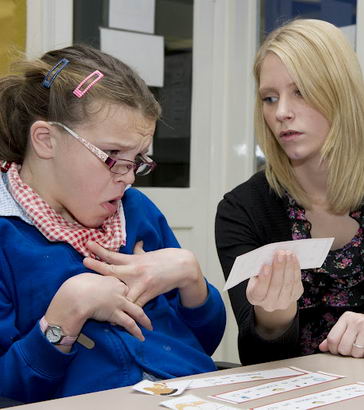
Attention deficit hyperactivity disorder (ADHD) or attention deficit disorder (ADD) is characterised by inappropriate impulsiveness, chronic inattentiveness and, sometimes, hyperactivity.
Children with ADHD/ADD may find it difficult to establish relationships with adults and other children because they tend to behave in a way that both adults and children find difficult. For this reason, children with ADHD sometimes develop secondary emotional difficulties.
Boys are diagnosed with ADHD five times more frequently than girls.

Research suggests that ADHD may have a genetic basis leading to a subtle brain dysfunction which causes deficiency in neurotransmission in the brain cells.
Genetic research also suggests that ADHD may be the result of abnormalities to the dopamine system, which is concerned with the regulation of movement.

Fifty per cent of children with ADHD have other areas of difficulty, such as dyslexia, language and/or hearing difficulties. There seems to be a particularly strong correlation between ADHD and dyspraxia and other conditions.

ADHD is usually diagnosed when:
- Several symptoms associated with impulsiveness and chronic inattentiveness have been present for several months
- These symptoms are inconsistent with the child’s developmental level, and
- The symptoms are presenting significant barriers to learning a school and being part of family life at home.
But many young children fit this profile at some time in their childhood because the ability to sustain attention and keep still for long periods develops gradually over time.

For a child to be able to sustain attention, the prefrontal cortex, which is concerned with self-control, must have reached a certain level of maturity. However, the frontal lobes of the brain continue to develop into adolescence or early adulthood and develop more slowly in some children than others. This can lead to over-diagnosis when an immaturity of the brain is mistaken for ADHD.
At present there are no biological markers for ADHD but, in future, more refined methods of behavioural testing, informed by findings from neuroscience has the potential to improve diagnosis for ADHD.

Many children with ADHD are given prescription medication to treat their condition. The medication most commonly prescribed is methylphenidate (Ritalin).
Methylphenidate works by affecting some of the natural chemicals that are found in the brain. In particular, it increases the activity of chemicals called dopamine and noradrenaline in areas of the brain that play a part in controlling attention and behaviour. These areas seem to be underactive in children with ADHD. It is thought increasing the activity of these chemicals improves the function of these underactive parts of the brain.

Medication cannot cure ADHD but it can help some children behave in a more acceptable manner.
For children with ADHD medication can help them:
- Become less aggressive
- Interact more effectively with others
- Remain more focused, and
- Become less impulsive.

The prescription of medication for ADHD is controversial. There can be side-effects, including headaches, irritability and slow growth and some children do not like the way they feel when they are taking medication. If medication is seen as the whole answer then other needs within the child's life can be overlooked.
Where medication is used evidence suggests that it is most effective as part of a multi-modal approach (NICE, 2008), eg in conjunction with:
- Therapy
- Educational intervention to address any learning difficulties that the child may have, and
- The use of particular behavioural strategies at home and at school.

Because of concerns around reliance on medication to manage ADHD and because self-control has been found to be an important predictor of academic success, research is underway to investigate whether cognitive training programmes can influence brain development, so that self-control can be developed through appropriate teaching.
It is therefore important for teachers to stay up to date with the research and debate in this area. If you don't have access to the latest thinking ask paediatricians and psychologists to update the school on the latest research.

Children with ADHD benefit from sticking to a routine. There should be clear rules at home and in the classroom, with agreed rewards for sticking to them and consequences if they do not. The rules and consequences need to be applied consistently by everyone involved with the child.

Approaches include:
- Removing objects that the child may fiddle with and letting the child select one thing to hold that will help them concentrate – stress balls are often effective
- Seating the pupil near the front of the class, facing away from other pupils and near good role models
- Providing a non-distracting work environment, free from wall displays and away from areas that other children need to walk through, and
- At home, using a quiet, distraction free space for homework.

Approaches include:
- Making tasks short and allowing frequent breaks for the child to move around
- Giving simple, clear instructions
- Making sure the child is attending before giving instructions
- Making sure the child has understood instructions before beginning a task, and
- Using a timer to help the child complete a task in a specified period.

Approaches include:
- Noticing and rewarding good behaviour and celebrating achievements
- Staying calm, and
- Avoiding sarcasm and ridicule – devising private signals to let children know when they are off task or behaving inappropriately might help.
Consider a child with ADHD in your class and build up a case study about this child taking account of the information in this package.
Consider:
- The nature of the child’s ADHD and how this manifests itself
- Associated difficulties
- The range of professionals that work with the child and what they do, and
- The range therapies and interventions used with the child.
Consider also:
- The child’s strengths, and
- The barriers to learning and participation that the child faces

What is done to remove barriers to learning and participation for that child – in your class and across the school? Identify personalised adjustments as well as more general adjustments that benefit the child you are focusing on and other children.
What could be improved in your own practice to remove barriers for the child? Identify one thing that you could change.
Change it and evaluate the impact on the child’s participation and/or learning.

Blakemore, S. and Frith, U. (2005), The Learning Brain: lessons for education, Blackwell Publishing
Cooper, P. and Bilton, K. (1996) Attention Deficit/Hyperactivity Disorder. London: David Fulton.
Hanbury, M. (2005) Educating Pupils with Autistic Spectrum Disorders: A practical guide. London: Paul Chapman.
Hughes, L. and Cooper, P. (2007) Understanding and Supporting Children with ADHD: Strategies for parents and other professionals. London: Sage Publications.
Thompson, R. (1993) The Brain: A Neuroscience primer (2nd edn). New York: Freeman.

Touchette, P. and Howard, J. (1984) Errorless learning: reinforcement contingencies and stimulus control transfer in delayed prompting, Journal of Applied Behavior Analysis, 17 (2), 175–188. US Department of Education, Office of Special Education and Rehabilitative Services.
Special Education Programs (2004) Teaching Children with Attention Deficit Disorder: Instructional strategies and practices. Washington, DC: US Department of Education.